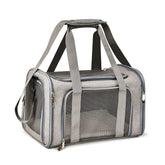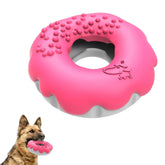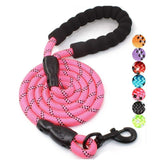If you see your dog scratching or biting their tail more often than usual times then chances are they have fleas on their body. The fleas are the tiny parasites which suck blood to survive. Fleas on dog's skin can cause serious issues or diseases. Some of the aftermaths are skin allergies and even anemia if not handled quickly and in right manner.
The worst part is that they multiply on the skin after a while. So, if you choose to ignore one flea as “It's just one, it’s fine.” You are probably making it hard for your pet, as it can turn into a serious skin infection or loss of blood in their bodies.
It is why taking quick action is important. In this blog, you will cover what are the important aspects to get rid of fleas on dogs quickly. Learn how to spot dog fleas and then take long-term prevention tips. So, don’t worry whether your dog got it from the park or while playing with other dogs, we’ve got you.
What Are Fleas?
If you’re a new dog parent, you must be unaware of these little bloodsuckers. They are tiny, wingless insects and just the size of a pinhead that survive by feeding on your dog’s blood. They are typically dark or reddish brown in colour. While they are hard to spot on the dog’s skin but the impact they make to your dog makes them go impatient, trying to scratch endlessly.
So, since they are too small, it might be easy to catch them with the fingers, right? Well, here they trick you. These pests have good speed, they don't fly but can hop with their legs from pet to pet or from a carpet to your dog in a second.
The problem is, fleas reproduce like wildfire. A single female flea can lay up to 50 eggs a day, which fall into your dog’s bedding, the carpet, and furniture. That’s how an unnoticed flea turns into a home-wide flea problem before you know it.
Signs Your Pet Might Have Fleas
Sometimes, fleas make their presence known right away. Other times, it’s difficult to catch. So, here are the signs that you can notice to know if your dog has fleas or not.
- Scratching or biting themselves more than usual
- Restlessness or trouble settling down
- Red bumps or irritated skin, especially near the tail or belly
- Hair loss or bald spots, caused by excessive scratching
- Tiny black spots on the skin
However, in severe cases, they cause anemia, which can be identified if they have pale gums or feel really lazy or inactive. If you spot any of the above signs, it indicates that fleas on dogs are present. Take action right away.
Comb Your Pet to Check for Fleas
Now that you know your dog has fleas, what to do next? Panic, NO! Your dog is already in panic mode. The best you can do is grab a flea comb and do a quick check. These fine combs are great at pulling these fleas and dirt from your dog’s skin. Comb from the upward direction around the ears, base of the tail, and belly. Don’t forget to comb it behind the ears, this is where you can find most of the fleas.
Run the comb through your dog’s coat slowly and wipe it on a white paper towel. If you see small, black, pepper-like flakes that turn reddish when wet, that’s flea dirt—a definite sign.
Grooming Helps Spot Fleas and Ticks
Grooming is not just for fancy spa days—it’s also your first line of defense. Regular brushing helps you catch fleas and ticks early. Use a dog grooming brush to use on your dog’s coat at least once a week, especially at the time of warmer months.
Plus, brushing is a bonding moment! Your dog gets a mini massage, and you get peace of mind.
Flea Bites and What They Do
Flea bites aren’t just itchy. For some dogs, they’re downright painful. You might notice:
- Intense itching and red welts
- Open sores or skin infections from scratching
- Flea allergy dermatitis (FAD), where a single bite results in an entire allergic reaction
If your dog is bitten by fleas and not treated, the bites can potentially result in hot spots, infection, or life-threatening disease.
How to Get Rid of Fleas on Dogs Quickly
If you want to know how to get rid of fleas on dogs quickly, follow this step-by-step approach:
Start with a fast-acting flea treatment
Go for vet-recommended oral or topical flea treatments. Some pills, like Capstar, start killing fleas in 30 minutes.
Bathe your dog with a flea shampoo
This will help wash off live fleas and soothe itchy skin. Make sure to leave the shampoo on for the recommended time.
Use a flea comb
After bathing, use the comb to manually remove fleas and flea dirt.
Clean your dog’s environment
Wash all bedding, vacuum your house (especially under furniture), and use pet-safe flea sprays on carpets and upholstery.
Treat all pets in the household
Even if only one pet shows symptoms, treat them all. Fleas jump, remember?
Consistency is key—don’t let your guard down too soon. Follow up with monthly preventatives to stop fleas from coming back.
Home and Environmental Treatment
Killing fleas on your dog is just half the job. You also need to get them out of your home.
- Vacuum daily for at least a week—floors, rugs, furniture, and corners
- Wash all pet bedding in hot water
- Use flea sprays or foggers if you’re dealing with a major infestation (just make sure they’re safe for pets)
- Don’t forget to treat other pets at home, too
Prevention Tips to Keep Fleas Away
Once you’ve evicted the fleas, here’s how to make sure they don’t come back:
- Use monthly flea preventatives—your vet can recommend the right one
- Stick to a regular grooming routine
- Keep your yard trimmed, especially during spring and summer
- Avoid areas known for fleas and ticks on dogs, like tall grass and dense woods
Take Charge Before Fleas Take Over
Fleas are fast, sneaky, and persistent—but you’re faster. With the right flea treatment for dogs, regular grooming, and a clean home, you can beat them and keep your dog happy and itch-free.
Don’t forget recognizing the signs early and knowing how to get rid of fleas on dogs quickly makes a huge difference. For the best flea control plan, check in with your vet they’ll help tailor a solution that fits your dog’s needs.

















